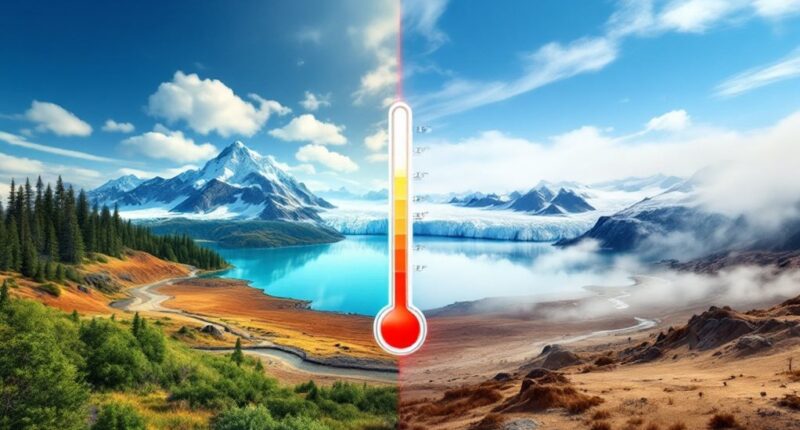Climate change represents Earth’s shifting weather patterns, intensified by human activities pumping excess greenhouse gases into our atmosphere. These gases—carbon dioxide, methane, and others—act like extra blankets on a summer night, trapping heat and raising global temperatures by 1.1°C since pre-industrial times. Natural feedback loops, like melting Arctic ice, further amplify warming effects. Solutions exist in renewable energy and improved efficiency—keys to turning down our planet’s thermostat before the disaster movie becomes reality.

While debates about climate policy may rage on in political spheres, the fundamental science of climate change rests on remarkably solid ground. At its core, climate change refers to long-term shifts in temperature and weather patterns, a natural phenomenon that’s been supercharged by human activities.
Think of Earth as a greenhouse with a thermostat that’s been cranked up – the glass letting sunlight in but trapping the heat, except in our case, the “glass” is an invisible layer of greenhouse gases like carbon dioxide and methane.
The greenhouse effect itself isn’t the villain in this story – without it, our planet would be a frosty -18°C instead of the cozy 15°C average we enjoy. The problem is we’ve been beefing up this natural blanket by pumping extra greenhouse gases into the atmosphere. It’s like adding extra blankets to your bed in summer – what was once comfortable becomes increasingly unbearable.
Earth’s greenhouse effect isn’t the villain—it’s our overzealous addition of atmospheric blankets that’s turning comfort into crisis.
Scientists have observed a 1.1°C increase in global average temperatures since pre-industrial times – a fever that might seem small until you consider that during the last ice age, the planet was only about 5°C cooler than today.
This warming has kicked off a cascade of effects: rising sea levels (the ocean’s way of saying “I need more room as I heat up”), shrinking Arctic ice (melting faster than ice cream on a sidewalk in July), and weather events that increasingly resemble scenes from disaster movies. The Paris Agreement established the critical target of limiting warming to well below 2°C while pursuing efforts to stay under 1.5°C above pre-industrial levels.
Perhaps most concerning are climate feedback loops – nature’s version of a vicious cycle. Melting Arctic ice means less sunlight reflected back to space, which means more warming, which means more melting. It’s like a snowball rolling downhill, except it’s actually the opposite – a no-snowball rolling uphill. These cycles are further amplified by increased water vapor, which acts as a powerful greenhouse gas feedback intensifying warming effects.
The scientific consensus is overwhelming – about 97% of climate scientists agree that human-caused climate change is happening.
The good news? We have solutions. Renewable energy, improved efficiency, and protecting natural carbon sinks can help us turn down Earth’s thermostat before things really start cooking. Transitioning to clean energy sources like solar, wind, and hydropower represents one of our most powerful tools for reducing carbon emissions while meeting our growing energy needs.
Frequently Asked Questions
How Do We Know Climate Change Isn’t Just a Natural Cycle?
Scientists can distinguish natural climate cycles from human-caused climate change through multiple lines of evidence.
Current warming is occurring 10 times faster than post-glacial warming, with carbon isotope analysis confirming fossil fuel origins.
The pattern of warming—nights warming faster than days, stratospheric cooling with tropospheric warming—matches human greenhouse gas emissions, not natural cycles.
Climate models only match observations when human factors are included.
Natural cycles alone would actually predict cooling rather than the warming we observe today.
What Impact Does Climate Change Have on Extreme Weather Events?
Climate change dramatically intensifies extreme weather events worldwide. The data shows extreme events occurring three times more frequently than in the 1960s, with 74% of studied events made more likely or severe by climate change.
From longer, more intense heatwaves to stronger hurricanes with higher precipitation, the fingerprints of warming are evident.
Regional variations exist, with some areas facing increased flooding while others battle persistent drought, resulting in substantial economic losses and human casualties.
Can Individual Actions Really Make a Difference?
Individual actions do make a difference, but within context.
While personal choices like plant-based diets and reducing flights can contribute to 25-30% of needed emissions reductions, the bigger picture requires systemic change.
The beauty lies in collective impact—when enough people shift behaviors, markets respond and social norms evolve.
Think of it as voting with your wallet and lifestyle; each action creates ripples that, combined with millions of others, form powerful waves of change.
How Will Climate Change Affect Food Security Globally?
Climate change will dramatically reshape global food security through multiple pathways.
Crop yields could plummet by 20% in some regions by 2050 as extreme weather events intensify. The 345 million people already facing acute food insecurity will grow in number as agricultural systems falter.
While some northern regions may see temporary benefits, vulnerable populations in Sub-Saharan Africa and South Asia face the greatest threats.
The food transportation network’s vulnerability further compounds these challenges, potentially triggering widespread price volatility and scarcity.
What Technologies Show the Most Promise for Addressing Climate Change?
Several technologies show tremendous promise for tackling climate change. Renewable energy continues advancing rapidly, with dramatically cheaper solar panels and AI-enhanced wind turbines leading the charge.
Energy storage solutions, particularly next-generation batteries, are critical for managing variable renewable sources. Carbon capture technologies, while still developing, remain essential for net-zero scenarios.
Digital innovations like AI and smart grids help optimize resources and improve climate modeling. Success will require deploying these technologies together rather than seeking a single silver bullet.









